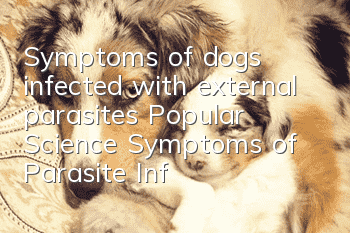Symptoms of dogs infected with external parasites Popular Science Symptoms of Parasite Infection

Flea
Severe itching and scratching: severe cases may lead to hair loss.Flea allergy dermatitis: This is one of the most common skin diseases in dogs and cats. It is caused by stimulation of the saliva of fleas when they bite pets.
Transmission of tapeworms: Dogs and cats become infected by inadvertently eating fleas containing tapeworm eggs. Anemia: Anemia caused by flea bites is more common in puppies and kittens. Cat-scratch fever: It is mainly spread by fleas. People get the disease through cat scratches or bites. Most healthy people will not have symptoms, but people with weak resistance may develop severe systemic symptoms.
Ticks
Skin ulcers: Ticks attached to pets cannot be removed by force because the mouthparts of the ticks may be deeply embedded in the skin, causing severe local swelling and infection. Anemia: When tick infection is extremely severe, it will cause blood loss and even anemia in pets (especially puppies and kittens). Tick paralysis: Some hard ticks secrete neurotoxins in their saliva during the process of stinging and sucking blood, causing conduction disorders in the host's motor fibers, causing ascending muscle paralysis, which can lead to respiratory failure and death, which is called tick paralysis. Transmitting diseases: Ticks are the vectors of many diseases. One tick can carry hundreds of viruses, bacteria, spirochetes and protozoa.Lice
Lice parasitized on dogs not only suck blood, but also make the host itchy and unbearable, and can transmit many important human and animal diseases. The lifespan of a louse is about 6 weeks. Each female louse lays about ten eggs a day. The lice eggs can adhere firmly to the hair or clothes of people and animals. After about eight days, they hatch into larvae and bite and suck blood immediately. , after about two or three weeks, they can grow into adults after three molts. Itching: Itching is the main symptom, but the severity varies among individuals. Bugs or eggs: Small bugs can be found at the roots of hair follicles, which are light black, gray-white or red (suck blood).Methods of parasite transmission
Oral infection: Infection through eating and drinking water. Most parasites fall into this mode of infection.Transdermal infection: such as hookworm and schistosomiasis infection.
Contact infection: Most external parasites fall into this category, such as lice, fleas, ticks, mites, etc. Infection by arthropods: Some blood protozoa and nematodes of the order Filarialidae (the most common ones are heartworms). Transplacental infection: such as Toxoplasma gondii, etc.
Susceptible animals: animals that lack resistance to a certain parasite or are in a susceptible state when their immunity is low. The ultimate prevention and control measures
The basic principles of prevention and control: control the source of infection, cut off the transmission route, and protect susceptible animals.
Random articles
- Is it better for Dogo dogs to have their ears erect or cropped? A case of Dogo dog’s ear erection surgery will tell you
- What do dogs eat to protect their stomach? It is important to protect their stomach and treat gastrointestinal diseases in dogs.
- How to tell if your dog is fat? Is your dog overweight?
- How to train Tibetan Mastiff Four aspects teach you how to train Tibetan Mastiff
- Will your dog catch a cold if you blow the air conditioner? What should you do if your dog catches a cold if you blow the air conditioner?
- What should you pay attention to when your dog drinks water? Don’t be careless when it comes to your dog’s drinking water.
- The dog's mouth bites and shakes. Why does the dog's mouth occasionally shake and bite?
- How to cut a dog's hair? Do you know how to cut a dog's hair correctly?
- Can dogs eat raw eggs? Why can’t dogs eat egg whites?
- Common Dog Problems in Summer How to Deal with Different Dog Problems



